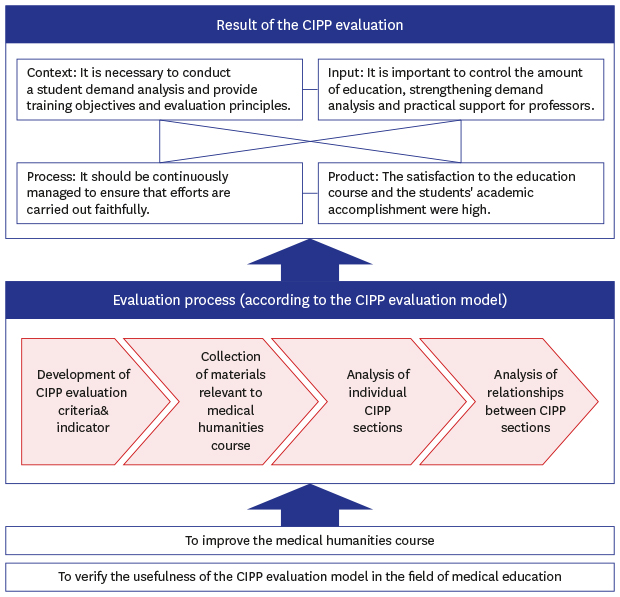1. Kim SC, Ro YS, Shin SD, Wi DH, Jeong J, Park JO, et al. Assessment of competence in emergency medicine among healthcare professionals in Cameroon. J Korean Med Sci. 2017; 32(12):1931–1937.

2. Epstein RM, Hundert EM. Defining and assessing professional competence. JAMA. 2002; 287(2):226–235.

3. Jung HY, Kim JW, Lee S, Yoo SH, Jeon JH, Kim TW, et al. A study of core humanistic competency for developing humanism education for medical students. J Korean Med Sci. 2016; 31(6):829–835.

4. Lee S, Chung MH, Yang E. Perception on curriculum reformation and evaluation of medical school. Yonsei J Med Educ. 2007; 9(2):1–12.
5. Lee YM, So YH, Ahn DS, Park SH. Evaluating clinical teaching in medicine. Korean J Med Educ. 2002; 14(2):293–300.

6. Park JH, Kim S. Evaluating clinical clerkship in medical school. Korean J Med Educ. 2004; 16(2):157–167.

7. Im EJ, Chang BH. Analysis on teaching evaluation of clinical clerkship at Korean medical schools. Korean J Med Educ. 2011; 23(2):119–126.

8. An JH, Han JJ, Kim NJ, Eo E, Kwon I, Lee SN. Analytical case study of evaluation of curriculum at a medical school. Korean J Med Educ. 2010; 22(1):57–64.

9. Neyazi N, Arab M, Farzianpour F, Mahmoudi M. Identifying weaknesses in undergraduate programs within the context input process product model framework in view of faculty and library staff in 2014. Korean J Med Educ. 2016; 28(2):185–194.

10. Jang ES, Hwang HS. Development of assessment criteria for education and training program of government-financed scientific and technical research institute based on CIPP. Korean J Technol Educ. 2015; 15(3):323–341.
11. Stufflebeam DL. The CIPP model for evaluation. In : Kellaghan T, Stufflebeam DL, editors. International Handbook of Educational Evaluation. Verlag: Springer Netherland;2003. p. 31–62.
12. Jung KY, Choi YH. Development of assessment criteria for scientific technology education program by science museum based on CIPP. Korean J Technol Educ. 2011; 11(2):85–103.
13. Kim SK. A content analysis of research on runaway youth in Korean journals from 2001 to 2010. J Adolesc Welf. 2013; 15(3):1–22.
14. Jeon WT. Research Methodologies for Social Medical Sciences. Seoul: Yonsei Univ. Press;1999.
15. Lee S, Chung MH, Shin JS, Chung EK. A survey on the introduction of medical humanities and sociology into the national medical licensing examination. Korean Med Educ Rev. 2010; 12(1):33–41.
16. An JH, Kwon I, Lee SN, Han JJ, Jeong JE. Study on the medical humanities and social sciences curriculum in Korean medical school: current teaching status and learning subjects. Korean J Med Educ. 2008; 20(2):133–144.

17. Chen YT. New course of medical education. Yonsei J Med Educ. 1999; 1(1):31–33.
18. Chen YT, Yang EB. Future of Medical Humanities and Medical Education. Seoul: Yonsei Univ. Press;2003.
19. Chung MH. A Report of Curriculum Evaluation. Seoul: Yonsei University College of Medicine;2005.
20. Jeon WT. Suggestions for the improvement of medical humanities education. Korean Med Educ Rev. 2010; 12(1):23–31.
21. Jung JY, Lee HS, Kim SJ. A hierarchical analysis of the factors influencing on student achievement: using the teacher and student factors of TIMSS 2011. J Korean Teach Educ. 2014; 31(2):53–75.
22. Jeong EI. Perceptions by teachers and students of good teaching at college. Korean J Educ Methodol Stud. 2010; 22(3):25–44.
23. Song CJ. A study on the teaching and learning activities, student-teacher communication, and course satisfaction. Asian J Educ. 2014; 15(2):171–200.
24. Kim YJ, Son EK. A study on satisfaction of new nurse orientation program applying CIPP evaluation model focusing on affiliated hospitals of an educational foundation in South Korea. J Korea Acad Ind Coop Soc. 2017; 18(9):226–235.










 PDF
PDF Citation
Citation Print
Print




 XML Download
XML Download